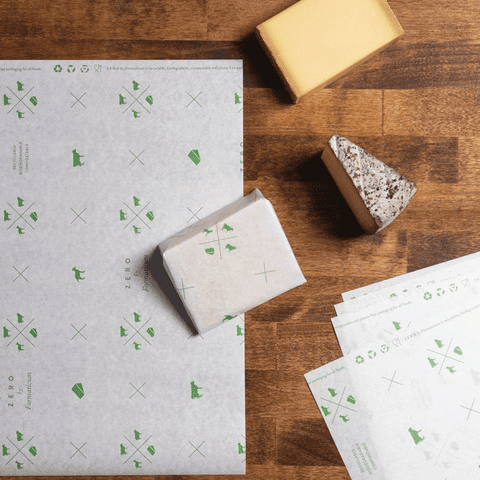

While there are no hard rules when it comes to enjoying cheese, there are rules for properly storing cheese to avoid food waste. When traveling on a cheese-focused trip in France, Formaticum founder Mark Goldman keenly noticed how Parisian cheese shops wrapped and packaged their cheese. They weren’t using plastic. So, Mark filled the gap in the United States and voila—Formaticum cheese storage paper was born. Their two-ply paper and storage bags are designed to maintain humidity and prevent cheese from drying out. We caught up with Mark about how to wrap your cheese and make it last:
What are the three best practices for storing cheese at home?
1. The most important thing is to avoid plastic film at all costs.
2. Once your cheese has been properly wrapped, keep it refrigerated in a part of your fridge that is less susceptible to temperature fluctuations from opening and closing the door—we recommend a drawer, which will also help prevent the cheese from taking on aromas and flavors from other items in your fridge. You can also avoid temperature abuse by cutting and serving only what you need—repeatedly bringing the entire piece of cheese to room temperature and then placing it back into refrigeration will negatively affect the texture and flavor of the cheese.
3. Lastly, if you can, we recommend buying less cheese more often. Buy only what you need for a few days, which ensures you always consume cheese that is as fresh and flavorful as possible instead of cutting pieces off a larger block that has lived in your fridge for weeks. While a whole wheel of cheese can age for years with no issues, the spoilage clock starts ticking for the smaller pieces as soon as the wheel is cut open.
What signs should consumers look for to determine if cheese has been stored incorrectly or has gone bad?
Some signs that your cheese might be past its prime are surface mold or discoloration and inconsistency in the paste. You should also avoid visibly dried-out cheese and cheeses that are cracked on the face, as they will likely taste unpleasant and stale. For softer cheeses, it is probably time to toss that piece if the paste is too liquidy or the rind is slimy with a distinct ammonia smell. The most important thing to remember is to trust your senses and use your judgment— they are your best tools. Separately, if you are buying precut cheese, look at the pack date and try only to purchase cheese cut a few days prior.
Also, surface mold is only sometimes an immediate indicator that a cheese is beyond hope. Harder cheeses can be triaged by cutting off ¼ inch (or to your comfort level) from the affected side. Cheese microbiologists have said that the roots of the mold spores cannot penetrate too deeply into a dense product such as aged cheese. And molds used in cheesemaking are entirely safe to eat! But again, use your best judgment to decide what suits you and your needs.
What are the top three techniques consumers should keep in mind when wrapping cheese to maintain freshness and flavor?
1. Remove any cling wrap or additional packaging before placing your cheese in a Formaticum bag or wrapping it in our cheese paper. We also recommend gently scraping the surface of the cheese with a knife to remove any excess grease or butterfat before placing it in your fridge, which will help preserve the cheese longer.
2. Ensure the wrap or the bag is fully sealed in the refrigerator to create and secure the ideal environment for cheese storage. The fancy French pleat looks nice but also serves a purpose to seal the package and fully protect the cheese inside.
3. My controversial tip: Remove the rind on aged/natural-rind cheeses before wrapping for storage. The rind is a source of mold that can spread to the surface of the cheese. If you are not using the cheese for a display or presentation, it serves no purpose.




